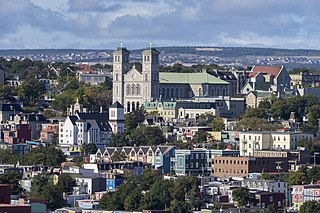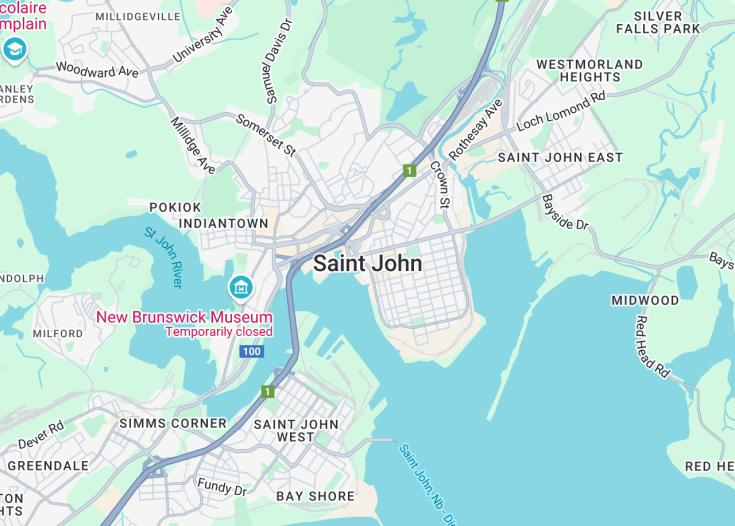Saint John, located in the picturesque province of New Brunswick, Canada, is renowned for its rich history and vibrant culture. This coastal city, established in 1785, is not only the oldest incorporated city in Canada but also a hub for maritime adventure and historical exploration. Visitors are captivated by its scenic landscapes, from rugged cliffs to sweeping tides at the Bay of Fundy. The city’s architecture, museums, and live music scenes weave a cultural tapestry that celebrates its diverse heritage and contemporary creativity.
Explore the City Market, one of the oldest continuing farmer’s markets in Canada, perfect for experiencing local flavors and crafts.
Schedule your visit during the Fundy Fringe Festival for a unique blend of theatre and performances by local and international artists.
Top things to do & see in Saint John
Select the following sights and activities to discover best tickets and tours available in Saint John.
Saint John: A Maritime Gem in Canada
| Country | Canada |
| Time in Saint John | GMT-4 |
| Language spoken | English |
| Population | 67,575 (Statistics Canada, 2021) |
| Currency | Canadian Dollar (CAD $) |
| Airports | Saint John Airport (YSJ) (9 mi / 14.5 km). |
Saint John, founded in 1785, is one of Canada’s oldest cities, with a rich history that mirrors the development of the nation itself. As the first incorporated city in Canada, Saint John boasts a vibrant cultural scene with deep roots in maritime history. Situated on the north shore of the Bay of Fundy, the city experiences the highest tides in the world, which have shaped both the geography and the life of its residents.
The historic streetscape, primarily made of sandstone and brick, tells stories of a time when Saint John was a haven for shipbuilding and timber trading. The city’s architecture, like the remarkable Imperial Theatre and the historic City Market, reflect Victorian influences and are testaments to its storied past. The ongoing regeneration of Saint John’s waterfront has transformed former shipyards into bustling markets, museums, and galleries.
Today, Saint John is known not only for its scenic beauty and historical significance but also for its forward-thinking approach to urban living and community development. The city’s focus on sustainability and innovation draws a dynamic mix of both residents and businesses alike.
Where is Saint John?
Saint John is located on the southern coast of New Brunswick along the Bay of Fundy, famous for the world’s highest tides.
Distances:
| Route | Distance by car | Time by car |
|---|---|---|
| Toronto to Saint John | 990 km | 10 hr 30 min |
| Montreal to Saint John | 790 km | 7 hr 45 min |
| Ottawa to Saint John | 855 km | 8 hr 50 min |
What is Saint John famous for?
Saint John is renowned for its historical and cultural significance in maritime heritage, featuring Victorian architecture, a lively arts scene, and breathtaking natural phenomena such as the Reversing Rapids.
History
Pre-Colonial Period – Before 1604
The area now known as Saint John was originally inhabited by the Wolastoqiyik and Mi’kmaq peoples, who used the region for fishing, hunting, and gathering. The rich natural resources and strategic location at the mouth of the Saint John River made it a significant area for Indigenous communities long before European contact.
Colonial Era – 1604-1867
European exploration began when French explorer Samuel de Champlain arrived in 1604. The region was then named by the French after the Saint John River. In 1631, Charles de Saint-Étienne de la Tour established Fort La Tour, a fur trading post and one of the first permanent European settlements in North America. The area became a battleground between the French and the British during the colonial wars. The 1758 British conquest led to the establishment of New Brunswick as a British colony in 1784, and Saint John became Canada’s first incorporated city in 1785, fueled by Loyalists fleeing the American Revolutionary War.
The Industrial Age – 1867-1950
Post-Confederation, Saint John rapidly industrialized. The city became a hub for shipbuilding and timber trade, which dramatically shaped its economy and infrastructure. Major fires in 1877 and 1905 caused extensive damage but led to robust urban planning and rebuilding, fostering a resilient civic identity. The establishment of rail connections further helped in the economic expansion, making Saint John a central player in Canada’s growth during the Industrial Revolution.
Modern Era – 1950-Present
The mid-20th century saw Saint John diversifying its economy with the growth of the service sector and urban development. Recent decades have focused on cultural revitalization and the enhancement of its historical sites to boost tourism. The revitalization of the Saint John waterfront and the development of the Harbor Passage are recent endeavors aiming to link the city’s rich history with modern tourism and recreational activities.
Visit Saint John
What to see and do in Saint John, Canada
Explore the vibrant city of Saint John, characterized by its rich history and charming maritime culture. Notable attractions include the historic Saint John City Market, boasting a range of local crafts and fresh produce; the stunning Reversing Falls Rapids, a unique natural phenomenon; and the New Brunswick Museum, where visitors can delve into the region’s geological, biological, and cultural history. Outdoor enthusiasts will enjoy Rockwood Park, one of Canada’s largest urban parks with extensive trails and pristine lakes.
Festive Seasons in Saint John
The city of Saint John comes alive with several events throughout the year. The Saint John Sea Dogs Festival in summer celebrates maritime culture with ship displays and sea-themed activities. Winter is marked by the popular Saint John Winterfest, a festival that offers a variety of ice and snow activities and is typically held in February.
Best time to visit Saint John
The best time to visit Saint John is during the summer months from June to September when the weather is warmest and the city hosts numerous festivals and events. Fall is also an ideal time for a visit, offering vibrant foliage and comfortable temperatures.
Is Saint John worth visiting?
Saint John is undoubtedly worth visiting for those intrigued by rich historical tapestries and natural beauty. The convergence of culture, history, and the scenic environment offers something for every traveler. Its well-preserved heritage buildings alongside modern developments provide a fascinating glimpse into both the past and present of maritime Canada.









